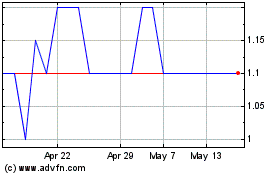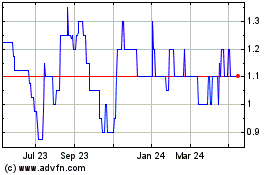TIDMGLR
RNS Number : 9274T
Galileo Resources PLC
23 March 2023
23 March 2023
Galileo Resources Plc
("Galileo" or "the Company")
Kamativi Lithium Project, Zimbabwe - New Discoveries
Galileo Resources plc ("Galileo "or the "Company") is pleased to
inform shareholders that exploration over the Kamativi Licence
("Project area") has led to the delineation of a number of
significant lithium, tin and rare earth element anomalies all of
which warrant further immediate investigation.
The Kamativi licence EPO 1782 covers an area of 520 sq km in
western Zimbabwe. Galileo has an option to earn an 80% interest
through spending a combined total of $1.5million on exploration and
evaluation in the Project area and over the Bulawayo gold-nickel
property by 21 July 2024.
The Licence is adjacent to the former Kamativi mine and hosts
strike extensions to the former mining district which produced
between 1936 and 1994 over 37,000 t of tin and tantalum from 27Mt
of tin-lithium-caesium-tantalum bearing pegmatites. In 2018,
Chimata Gold Corp. (Zimbabwe Lithium Company) announced a NI 43-101
compliant Indicated Mineral Resource of 26.3Mt at 0.58% Li(2) O,
493 ppm SnO(2) , 41 ppm Ta(2) O(5) & 65 ppm Nb(2) O(5) for the
Kamativi tailings project. The estimate was completed by MSA Group
(Pty) Ltd of South Africa.
Highlights
-- Highly encouraging initial exploration has identified 4
priority zones anomalous in lithium, tin, tantalum and rare earth
elements for immediate follow-up.
-- Zone 1 (west of licence): Pegmatite swarms with individual
pegmatites up to 30m wide have revealed a coherent
Li-Cs-Nb-Sn-W-Ga-Rb- total rare earth element ('TREE') in soil
anomaly extending over 1.2km with a width of 300 to 500m and a peak
Li in soil content of 880ppm, with a further 1.5km extension (to
the limit of laboratory assays) with peak Li in soil content of
1,000ppm.
-- Zone 1 rock chip samples report up to 0.4% Sn and stream
sediment sampling from the surrounding area, distal to the soil
sampling report total rare earth elements peaking at 0.80%.
-- A further 2km long zone of prospective pegmatite lithology
associated with elevated Li, Nb, W, Sn, Ga, Rb and a total rare
earth element geochemical response up to 0.45% TREE has also been
delineated.
-- Zone 2 (centre of licence): Rock chip and stream sediment
sampling indicates further potential for significant mineralisation
with rock chip peak values of 820ppm Li, 372ppm Cs and 617ppm Sn
from pegmatites.
-- Sampling of pegmatites from historic workings returned peak
Sn grades of 0.7% Sn in association with anomalous Ta, Nb and
Cs.
-- Zone 3 & 4 (east & northeast of licence): Rock chip
sampling returned anomalous Sn and Li values peaking at 0.2% Sn and
1060ppm Li.
-- Total rare earth element in soil values up to 1122ppm are
widely distributed over an approximate area of 7km(2) .
-- A leading battery metals consultant from CSA Global Ltd (an
ERM Group Company) has been commissioned to provide an independent
specialist assessment of the results and accompanying datasets. The
Company will announce the next steps for the area once this
assessment concludes.
Colin Bird Chairman and CEO said "We committed to a substantial
reconnaissance programme over all the potentially prospective
lithium terrain on the Licence comprising stream sediment, rock
chip and soil sampling, with 4,359 samples collected of which 1,282
were sent for laboratory analysis. This programme has identified
several significant targets in a number of areas within the Licence
where the peak analytical values, metal associations and continuity
are sufficiently coherent to allow us to plan an early follow up
programme including trenching and, where warranted, drilling, with
the programme to be guided by CSA's assessment. This initial
campaign has been extremely encouraging pointing us to a number of
high potential areas associated with the productive Kamativi
pegmatite terrain and we look forward to advancing this project at
a time when Zimbabwe and lithium are very much in the global
spotlight linked to New Age Metals".
Exploration and Sampling Programme
A total of 4,359 soil samples, 728 stream sediment samples and
221 rock chip samples were collected and analysed by portable XRF,
of which 1,282, 72 and 68 respectively were submitted for
laboratory geochemical determinations.
A QAQC collection regime of utilising approximately 5% blank
insertions, 5% certified reference material insertions and 5% field
duplicates was undertaken
All laboratory submitted samples were analysed by ALS Chemex
South Africa and ALS Chemex Ireland, fully accredited laboratories
that comply with international standards ISO 9001:2015 and
ISO17025:2017. ALS Chemex performed internal QAQC, and values fell
within acceptable ranges.
All samples were analysed for Li using a sodium peroxide fusion
and dissolution, with determination by ICP, with a 10ppm lower
limit of detection [analytical code, ME-ICP81]. In addition, all
samples were analysed for 32 elements including Cs, Nb, Ta, Rb, Ga,
Sn, W and rare earth elements using a lithium borate fusion
technique with determination by ICP-MS [analytical code,
ME-MS81].
Zone 1
Numerous pegmatites have been recorded based on field
observations. Pegmatite widths range from 1 to 30m, with pinching
and swelling along the observable surface trend. The highest
observed surface pegmatite density coincides with the peak
geochemical results. A significant coherent Li-Cs-Nb-Sn-W-Ga-Rb
TREE in soil geochemical anomaly extends over approximately 1.2km
with a width of 300-500m based on a 200ppm Li cut-off, with a peak
reported Li in soil content of 880ppm. Other elements of interest
report up to 465ppm Cs, 191ppm Nb, 964ppm Rb, 159ppm W, 421ppm Sn
and TREE content of 1142ppm, including 393ppm Ce, 348ppm Y and
180ppm Nd indicating the high degree of fractionation and
prospectivity for Lithium-Caesium-Tantalum ('LCT') pegmatites.
The Li in soil geochemical trend can be traced northeast for a
further 1.5km (to the limit of laboratory assays), up to 300m in
width with a peak Li in soil content of 1000ppm with similar
elements of interest and pathfinder geochemical associations.
An outcropping pegmatite was observed over 1km of strike,
typically 2-3m in surface observable width likely to be associated
with the peak Li in soil value.
Rock chip samples report up to 0.4% Sn and stream sediment
sampling from the surrounding area to the south and southeast
(distal to the soil sampling) indicates anomalies up to 0.80% TREE
associated with pegmatites within granitic terrain including up to
3120ppm Ce, 1575ppm La, 1345ppm Nd, 351ppm Dy, 366ppm Pr and 830ppm
Y which require follow-up.
A further zone anomalous in Li (110ppm) has been identified with
associated Nb, W, Sn, Ga, Rb and TREE geochemical responses (up to
0.45%) over 2km of prospective lithology associated with
pegmatites. The most significant observed pegmatite body is exposed
over 350m with an approximate observed width of 3 to 5m, trending
to the ENE with a sub-vertical dip.
Zone 2
Reconnaissance rock chip and stream sediment sampling indicates
further potential for significant mineralisation in this area. Rock
chip sampling returned values up to 820ppm Li, 372ppm Cs and 617ppm
Sn from pegmatites. Sampling of historic pegmatite workings from
the surround granitic terrain reported up to 0.7% Sn with up to
923ppm Ta, 415ppm Nb and 168ppm Cs. Stream sediment samples
returned anomalous Li, Cs and TREE values (up to 0.3%) which
require follow-up.
Zone 3 & 4
Rock chip sampling returned values up to 0.2% Sn and 1060ppm Li
associated with ENE trending, steeply dipping pegmatites (typically
2 to 3m in observable width) in old workings associated with the
extension of the Kamativi Formation.
Over part of the mapped extension of the Kamativi Formation,
weakly anomalous Cs, [Nb], Sn, W, [Ga], [Rb] in soils are reported
over an approximate area of 1.6km x 0.6km.
TREE in soil values up to 1122ppm are widely distributed over an
approximate area 7km(2) (note area not fully covered by laboratory
assays) in conjunction with anomalous Nb, Ga and Rb, associated
with northeast trending structures, outcropping porphyritic granite
and/or pegmatites with values up to 553ppm Ce, 261ppm Y, 248ppm La
and 192ppm Nd.
Technical Sign-Off: Technical information in this announcement
has been reviewed by Edward (Ed) Slowey, BSc, PGeo, Technical
Director of Galileo. Mr Slowey is a geologist with more than 40
years' relevant experience in mineral exploration and mining, a
founder member of the Institute of Geologists of Ireland and is a
Qualified Person under the AIM rules. Mr Slowey has reviewed and
approved this announcement.
You can also follow Galileo on Twitter: @GalileoResource
For further information, please contact: Galileo Resources
PLC
Colin Bird, Chairman Tel +44 (0) 20 7581
4477
Beaumont Cornish Limited - Nomad Tel +44 (0) 20 7628
Roland Cornish/James Biddle 3396
---------------------
Novum Securities Limited - Joint
Broker
Colin Rowbury /Jon Belliss +44 (0) 20 7399 9400
---------------------
Shard Capital Partners LLP - Tel +44 (0) 20 7186
Joint Broker 9952
Damon Heath
---------------------
The information contained within this announcement is deemed by
the Company to constitute inside information as stipulated under
the Market Abuse Regulations (EU) No. 596/2014 as it forms part of
UK Domestic Law by virtue of the European Union (Withdrawal) Act
2018 ("UK MAR").
Technical Glossary
"granite" A medium to coarse grained granular acid intrusive
rock
"pegmatite" Very coarse-grained igneous rock which commonly
occurs as dykes in granite intrusions
"porphyritic" A rock texture containing distinct crystals
or crystalline particles embedded in a compact
groundmass
"tailings" Reject products from a mineral treatment plant
"tantalum" A metallic mineral used in a variety of alloys
to add high strength, ductility and a high
melting point
"XRF" Analytical method to determine the chemistry
of a sample by measuring the fluorescent (or
secondary) X-ray emitted from a sample when
it is excited by a primary X-ray source
Abbreviations
Cs Caesium
Li Lithium
Ga Gallium
Nb Niobium
Rb Rubidium
Sn Tin
W Tungsten
ppm Parts per million
This information is provided by RNS, the news service of the
London Stock Exchange. RNS is approved by the Financial Conduct
Authority to act as a Primary Information Provider in the United
Kingdom. Terms and conditions relating to the use and distribution
of this information may apply. For further information, please
contact rns@lseg.com or visit www.rns.com.
RNS may use your IP address to confirm compliance with the terms
and conditions, to analyse how you engage with the information
contained in this communication, and to share such analysis on an
anonymised basis with others as part of our commercial services.
For further information about how RNS and the London Stock Exchange
use the personal data you provide us, please see our Privacy
Policy.
END
DRLUUSWRONUOUAR
(END) Dow Jones Newswires
March 23, 2023 03:00 ET (07:00 GMT)
Galileo Resources (AQSE:GLR.GB)
Historical Stock Chart
From Dec 2024 to Jan 2025

Galileo Resources (AQSE:GLR.GB)
Historical Stock Chart
From Jan 2024 to Jan 2025
